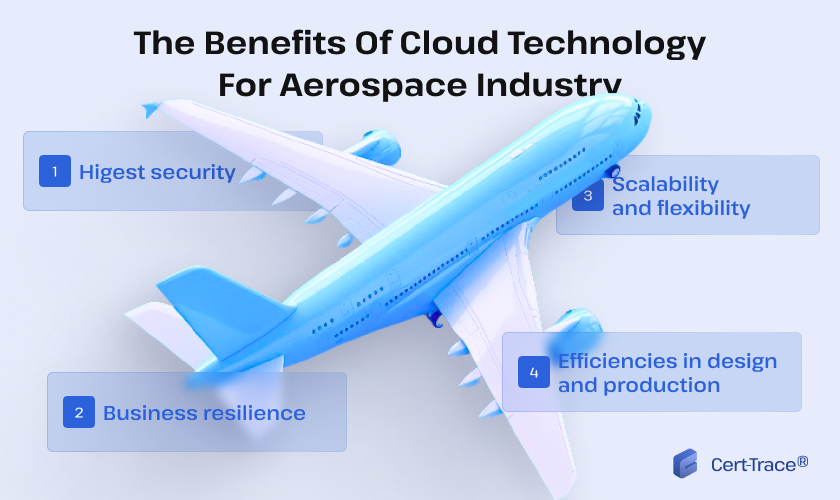The aerospace industry has been headed for the clouds ever since mankind first dreamed of taking to the skies, so it’s appropriate that it has been a pioneer in the use of cloud storage. But what has made cloud technology in aerospace so prevalent compared to other industries?
In this guide we’ll cover everything you need to know about why cloud-based software has become so widely used in the aerospace sector.
Why cloud technology in Aerospace is important
The pace of technological change in the aerospace industry is growing all the time, as you’d expect from a sector that has always required innovation and blue-sky thinking. Even now, new and exciting uses for technology like AI, automation and machine learning are being brainstormed and tested and have the power to change how we fly.
But what role does a cloud-based solution have to play? Within the aerospace industry in particular it has the potential to be hugely transformative, helping to allow to faster reactions to shifting circumstances with easy access to huge amounts of data across multiple global locations.
The sector has also had to evolve quickly since the disruption of the Covid-19 pandemic, which reduced the demand for commercial aircraft dramatically in the short-term, with lingering effects still felt today.
This has increased the need for driving efficiencies wherever possible and improving supply-chain performance, both of which are made possible through a cloud-based solution.

The benefits of cloud technology for Aerospace businesses
So what are the advantages of cloud technology in this sector? Here are some of the main ways that aerospace innovation can be driven through cloud storage.
1. Security
The aerospace sector requires the highest security, whether it is civil or military aviation, and one of the main benefits of cloud technology, particularly when it is a blockchain-based solution, is that critical data is kept secure.
This is achieved through decentralization through blockchain technology, meaning that there is no potential single point of failure where these documents can be hacked into as nothing is stored intact on any one single shared server.
The documents are encrypted and broken up into chunks which are distributed across a network, which means that even if one is breached, only fragments of data are exposed and the hackers can’t access anything meaningful.
The documents are also secure because no unauthorized transactions are allowed to take place as consensus would be required from all trusted partners before they could happen. This means the integrity of the documents can be relied upon and there’s complete transparency about who has accessed what and when.
2. Resilience
Another important use of cloud technology in aerospace in recent years relates to business resilience. This was especially crucial during the peak of pandemic-enforced lockdowns when flights were grounded, staff were working from home and multi-national businesses needed to quickly find new ways of operating.
The cloud offered solutions to these kinds of issues, but most importantly the solutions delivered improved efficiency, meaning that as life and work returned to normal, the new ways of working stayed in place. Significantly, they also mean that aerospace businesses are in a strong place ahead of any future disruption.
3. Scalability and flexibility
Switching to cloud technology in aerospace has meant that businesses are much more able to scale up easily without being constrained by out-dated processes or structures, especially important for smaller businesses that have spotted opportunities to innovate during this time of great churn within the sector.
Having the additional flexibility to pivot as required not only offers resilience but also agility to take advantage of opportunities or respond to potential crises. After all, if staff across the globe can all access critical documentation, timezones don’t need to be a hindrance to a quick response when needed.
4. Efficiency in production
Innovation is key in the aerospace industry, and the cloud can help drive this through efficiencies in design and production. When it comes to design, having access to all of the necessary data at their fingertips, designers across the globe can collaborate and make the right decisions quickly, speeding up game-changing innovation.
These designs can then be quickly and efficiently tested and measured, with data gathered from multiple sources and analyzed to find strengths and weaknesses. Then the successful designs can be moved into production more cheaply, with automated systems detailing inventory levels, forecasting demand and optimizing production techniques. All of this helps aerospace businesses react more quickly, work together more effectively and deliver better results more quickly for less money than would have been spent before.
How cloud technology has changed the Aerospace industry
So, this is how the cloud has the potential to drive innovation and improvements within the aerospace sector, but what kind of impact has it made so far? While it is an industry that’s blazing a trail for cloud technology, stats from Accenture suggest that only 54% of aerospace and defense companies say that they’ve defined a new IT operating model that accommodates the cloud.
This is despite 93% of executives saying that the pace of innovation in their organizations has accelerated in the past three years because of emerging technologies. So clearly there is still room for improvement in terms of how the cloud is being used, even in this innovative sector.
But there are examples of where it is making an impact. Boeing is using cloud computing to provide pilots with real-time analytics and improved flight control, while Airbus is utilizing it for working with supply chain partners to deliver aircraft maintenance and repair information.
Military organizations are taking the cloud to the battlefield via mobile devices to assist with data transmission to and from military networks, assisting with real-time decision-making. These are just a few ways that cloud-based technology is being used in the aerospace sector already for practical and potentially game-changing purposes.
If you want to find out how cloud technology can help your aerospace business innovate, secure your data and find cost and process efficiencies, why not get in touch with any questions to info@tracert.digital and start your journey to the cloud?
How useful was this post?
Click on a star to rate it!
Average rating 5 / 5. Vote count: 562
No votes so far! Be the first to rate this post.


